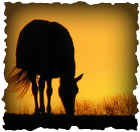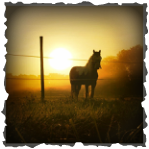Vaccines
|
Eastern/Western Equine EncephalitisAnnual
Mosquito-bourne, attacks nervous system. Symptoms:
InfluenzaEvery 3 months, if at a high risk of exposure
Common respiratory disease, very contagious. Symptoms:
|
||||||||
Some Common Horse Health Issues
Colic:
- Spasmodic colic is the most common form and occurs as a result of muscles spasms in the horse's small intestine. This type of colic usually results from stress or sudden feed changes but can also be caused by exercising too soon after feeding, drinking a lot of water too soon after exercise, or even by excessive anxiety/excitability.
- Tympanitic colic is caused by a build-up of gas, leading to over-destension of the stomach. This form of colic can occur if the horse gorges on feed (this is why it's important to store grain in a separate, closed off room), by eating un-soaked beat pulp (which then expands in the horse's stomach), or by the fermentation that occurs when a horse eats excessive apples or grass cuttings. Although it usually responds well to nasogastric tubing and medication, this type of colic can lead to a ruptured stomach if unattended to. The horse's large intestine is also prone to twisting with more severe gas colic, so it's important to seek prompt medical care.
- Impaction colic refers to the intestines becoming blocked, generally by food or fecal matter. Impactions can be caused by simple dehydration or by the ingestion of things such as straw and sand. It can also indicate a Strongyle infestation. This form of colic also usually responds well to treatment, provided that it was detected early.
- Obstruction colic includes displacements, strangulations, and torsions. Displacement is when part of the bowel moves to an abnormal section of the abdomen, while the other two types lead to a loss of blood supply to the gut. These are all more serious forms of colic, often requiring surgery. Early symptoms for obstructions are similar to those of other types of colic, therefore it is important to call you vet whenever you suspect your horse may be colicing.
|
Prevention:
|
What to do if you suspect Colic:
|
TIP:
Sand colic can be detected or ruled out by mixing some of your horse's manure and water in a bag. Then wait to see what, if anything, settles to the bottom. |
Parasites:
|
Prevention:
|
- Strongyles (large and small redworms) are the most common equine intestinal parasite and a frequent cause of spasmodic colic. The worms can cause anemia while the hatched larvae often lead to intestinal inflammation, roughening of the arterial wall and clot formation. Large strongyles are most dangerous because they migrate outside of the intestine and into blood vessels and organs.
- Roundworms are large, stiff, white worms which infect the small intestine and can damage both the liver and the lungs during migration. Horses develop immunity to this type of infestation at around the age of 2.
- Tapeworms can be asymptomatic but also responsible for causing some surgical colics and are most prevalent in areas with acidic soil. Heavy infestations cause ulceration and blockages.
- Bots are bot fly larvae, laid on the horse's coat (often on their legs) and lick/ingested later. These larvae develop for 8-10 months over the winter and can cause hemorrhaging, ulceration and perforation of the horse's stomach.
Heaves:
Symptoms:
|
|



